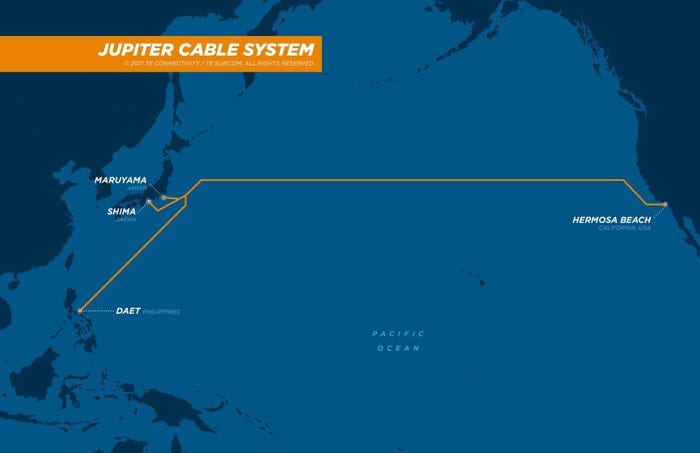A new consortium appears to lay another massive cableA new consortium appears to lay another massive cable
A horde of big names has come together to build a high-capacity cable system that will connect Maruyama and Shima in Japan with Los Angeles in the USA and Daet in the Philippines.
October 31, 2017

A horde of big names has come together to build a high-capacity cable system that will connect Maruyama and Shima in Japan with Los Angeles in the USA and Daet in the Philippines.
So who is in the consortium; PCCW Global, Amazon, Facebook, NTT Communications, PLDT and SoftBank. Scheduled to be ready for service by early 2020, the Jupiter Cable will be approximately 14,000 km in length and has a design capacity of more than 60 Tbps.
“The demand for bandwidth in the Pacific region continues to grow at a remarkable rate, and is accompanied by the rise of capacity-dependent applications like live video, augmented and virtual reality, and 4k/8k video,” said Koji Ishii of SoftBank, co-chairperson of Jupiter consortium.
“Jupiter will provide the necessary diversity of connections and the highest capacity available to meet the needs of the evolving marketplace. TE SubCom has a proven record of success in the design and implementation of innovative, scalable and robust transoceanic cable systems, making the company the most reliable choice for the Jupiter supply partner.”
The cable itself has been configured as a trunk and branch system with submersible ROADM (reconfigurable optical add/drop multiplexer) using WSS (wavelength selective switch) for a gridless and flexible bandwidth configuration. The team claim the ROADM nodes in the design are the most advanced form of this technology to date, providing bandwidth reconfiguration flexibility in an undersea network.
Bandwidth demand over the trans-Pacific route has more than tripled in just four years, though this is only going to increase as new, bandwidth-intensive technologies including Virtual Reality (VR), social media applications, video streaming, and gaming content start to gain traction in the mass market.
“Consumers and enterprises continue to require significantly increasing amounts of bandwidth whether for their own applications, or for their interface with content providers, hosting companies and cloud services,” said Marc Halbfinger, CEO of PCCW Global. “The Jupiter network will play a crucial role in serving this increased demand across the key trans-Pacific artery.”
This is of course not the only cable which is being laid to deal with the rising demand of cat videos. Others include the Trident Subsea Cable, the Hawaiki cable and the FASTER cable. These are only three other examples, but the bottom of the ocean might start looking like the back of your PC before too long.

About the Author
You May Also Like










.png?width=300&auto=webp&quality=80&disable=upscale)


_1.jpg?width=300&auto=webp&quality=80&disable=upscale)